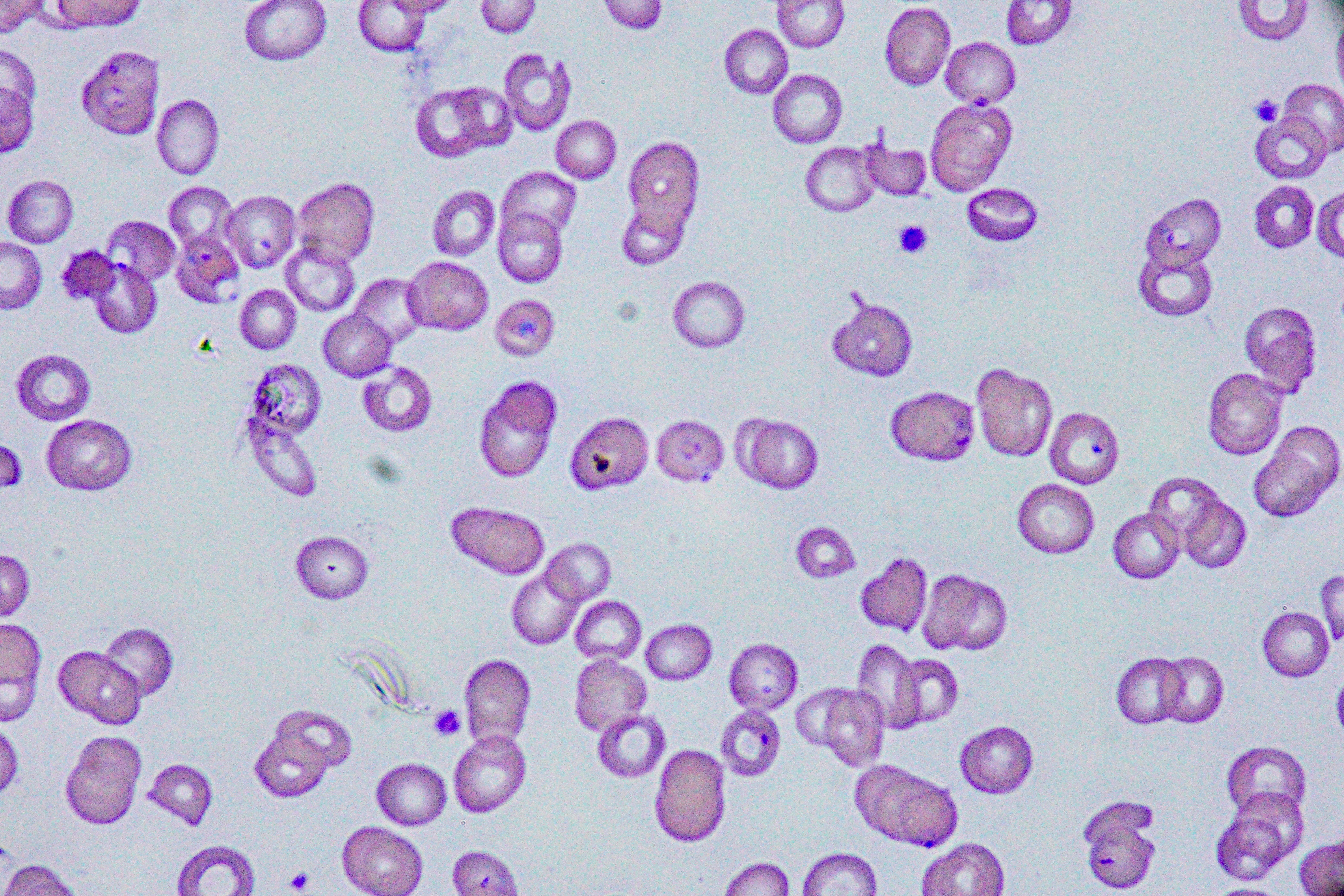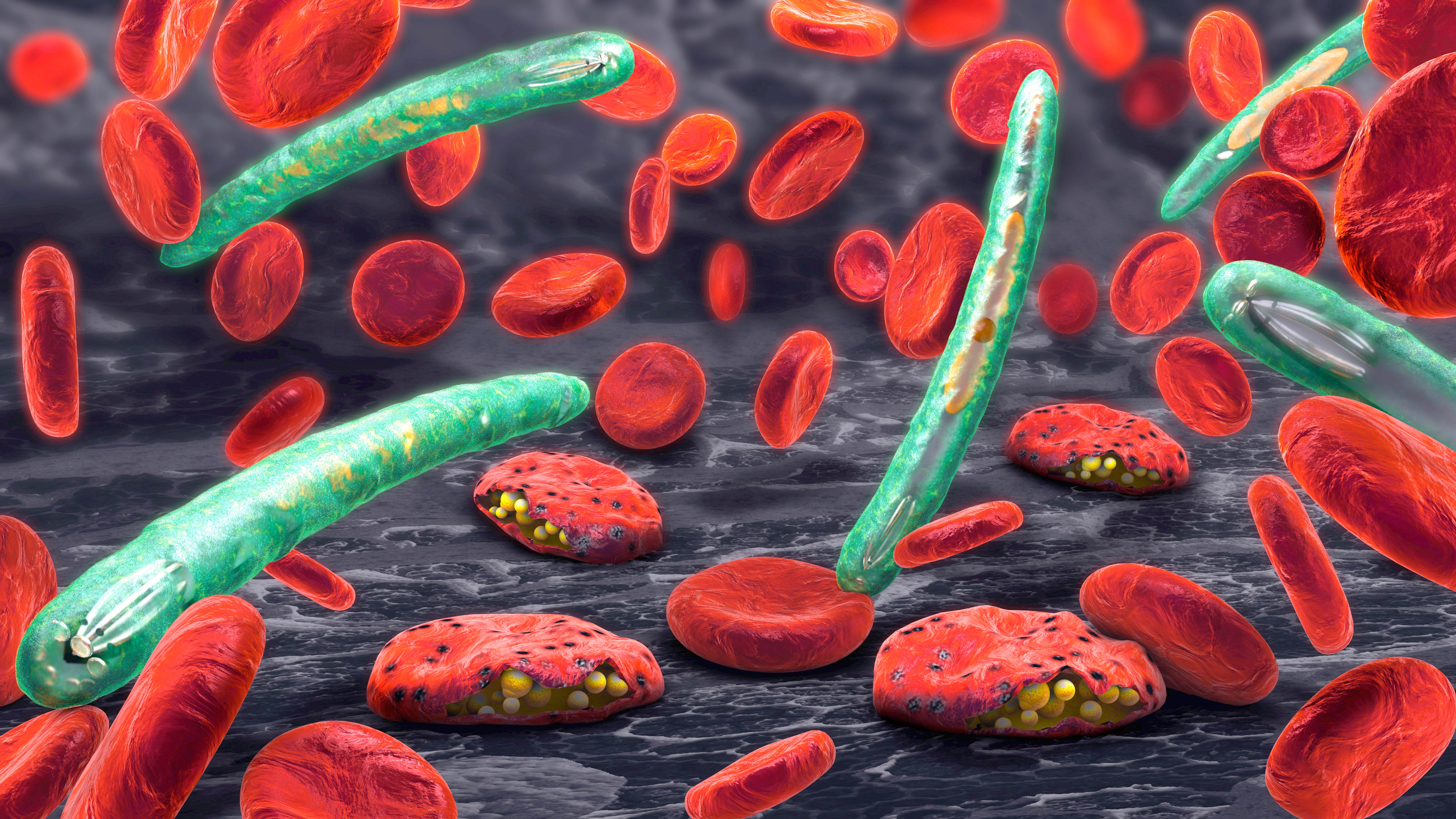So, in our lab, we need culture facilities in order to grow parasitised blood cells. We need an active insectary where we can grow mosquitoes, and we need the infrastructure so we can bring a deadly pathogen together with a heat-seeking hypodermic needle – the mosquito – under conditions that are safe. It is a very involved process just to study the parasite. But once we have got infected mosquitoes, infected cells, we can then either purify parasites or look at infected tissues under the microscope. We can do a huge amount once we have that complicated but standard set-up.
The malaria parasite
Professor of Cell Biology and Infectious Diseases
- Malaria has been with humanity right from the beginning and way before. We have this intimate relationship with the parasite, which goes through a mosquito and into a person, and then back to a mosquito and back to a person.
- The infected mosquito has parasites in its stomach. Those parasites swim their way through the body all the way to the salivary glands of the mosquito. They wait in these salivary glands until the mosquito is ready to bite.
- As researchers, we understand its basic biology. We understand how it transmits. We have had its genome since the early years of the millennium. But there are still some fundamental elements missing. We do not understand why a child dies from malaria.
How does malaria get into our body?

The way the malaria parasite gets into our body is a fascinating question. It is related to what kind of organism it is. Most people think that malaria, as an infectious agent, would be a virus or bacteria; in fact, it is a parasite. As a parasite, it is classified as a eukaryotic cell. We are eukaryotic cells. We have a nucleus; we have a complex cell. The malaria parasite is the same thing. It is a complicated cell. That is one of the reasons why it is so challenging to address. It has this incredible Everest-type journey every time it goes through an infection cycle. This journey starts out in the mosquito. When we think of what an organism is – how it evolved and where it come from – we often think about where an organism might have sex, and malaria parasites have sex in the mosquito. Malaria parasites and their relatives are ancient parasites, 250 or 300 million years old. They are mosquito-borne parasites; they live in the mosquito.
By chance, sometime in evolutionary history, they started to infect and passage through other organisms. Now, we have this intimate relationship with the parasite, which goes through a mosquito and into a person, and then back to a mosquito and back to a person. It is like a relay race with a baton: the mosquito passes the parasite to us, and we pass the parasite back to the mosquito.
How do we get infected?
We get infected during a mosquito bite, but it is much more nuanced than that. The infected mosquito has parasites in its stomach. Those parasites swim their way through the body all the way to the salivary glands of the mosquito. They wait in these salivary glands until the mosquito is ready to bite. When the mosquito bites us, it squirts out a little bit of saliva, so the blood does not clot. In that moment, the parasite passes from the mosquito – different temperature and different environment – to a warm human body. It goes into our skin. But that is only the beginning of yet another journey. It travels through the skin, finds a capillary, goes through the bloodstream and eventually finds the liver: its first home in the body.
From infection to disease
But that is not the moment when we get malaria disease. That is the first moment of infection. It lives within the liver for up to a week. After the liver, it bursts out and infects red blood cells. That is when we would say somebody is showing malaria infection. You can detect it. They will start to feel sick and have the symptoms of disease associated with malaria.
It is an incredible journey if we think right back to the beginning: from the mosquito stomach, to the liver, to the blood. What is beautiful is that the parasite is constantly changing. It is like the caterpillar-to-butterfly transformation. The parasite constantly changes its body plan, its phenotype. It is how the body might see it as it goes along this myriad journey. The process of infection is actually multi-step, multi-organism, multi-temperature; certainly nothing like any virus or bacteria. It is our standpoint of respect for this incredible parasite.
What tools do you need to study the parasite?
To understand how the malaria parasite works, to study its cell biology, you need a lot of infrastructure and processes. All of our work starts with blood cultures. We get blood given to us by the NHS, the National Health Service in the UK. They give us research blood that we grow parasites in. We can grow parasites continuously in blood that originally came from an infected patient, but they will infect and re-infect red blood cells in culture continuously. Then we have to stress them to make them form the next stage in their life cycle, which is a sexual stage. We take those sexual parasites and feed them to mosquitoes, and the female mosquito (only the females bite) will feed. It will take that blood up into the stomach. The male and the female parasites will then come together. They will infect the stomach. And that is when we get an infected mosquito.

Why is the malaria parasite so deadly?
One of the reasons why the parasite is so deadly is that it has two tricks up its sleeve.
The first is an element of its biology: it changes itself. It morphs into the same parasite and into different forms in different parts of its life cycle. The immune system will see cells that superficially look different: long skinny cells versus short round cells. Just as there are many cells in your body, in your genome, you have many different types of cells. So, the malaria parasite will also change its shape. That is one way of distracting or avoiding the immune system.
But the other trick is perhaps even more impressive. The parasite in the blood stage when you have malaria disease is living within a red blood cell. It is absolutely hidden from the immune system, but it still wants to grab onto or stick to epithelial cells and capillary cells so it does not get cleaned by the spleen. To do that, it has to put a protein out. When you put a protein out, the immune system is going to see it. It keeps putting out a new protein, one after another. Every time the immune system gets a chance to see the parasite and attack it within a red blood cell, that protein, which is put out on the red blood cell surface, changes it. The parasite is constantly changing that protein coat so the immune system cannot see it on the red blood cell’s surface. Combined with a constant changing of shape at different stages of the life cycle, it is an impressive game of hide-and-seek that the parasite plays.
So why is it so deadly? It is a good avoider, but it also has certain biological traits that are related to causing pathology.
What makes malaria so challenging?
What makes malaria so challenging and humbling as a scientist to work on is that it is an incredibly old disease. There are stories that Alexander the Great died from malaria. Every time ancient literature refers to fever, it is referring to malaria. It has been with humanity right from the beginning and way before; all primate lineages have malaria. It is an incredibly old wily foe.
As researchers in malaria, we stand on the shoulders of giants. They have made the key discoveries that malaria is borne by the mosquito, that it is a blood-borne infection. Those were profound discoveries because often they were going against the trends or against common misconceptions about what malaria is. It was only up until 50 years ago that the liver stage of malaria was even discovered. The journey of understanding each stage of malaria biology has been very long. It has required tenacity, and often going against the dogma of the time, in order to understand the biology of the parasite.
Research challenges today
Today, we are still struggling. By now, you would have thought we would have figured out a solution for malaria, but it is still extremely complex. It is a disease that represents not only amazing cell biology but also public health economics. Its impact is so broad and varied.

As researchers, we understand its basic biology. We understand how it transmits. We have had its genome since the early years of the millennium. We have a lot of tools, but there are still some fundamental elements missing. We do not understand why a child dies from malaria, what it actually dies of. Many discoveries have been made over the years, but there is still a huge amount to discover and understand. That is what keeps labs like mine and people like me invested and passionate about gaining understanding that will help us beat this ancient foe once and for all.
Modern malaria research techniques
To give a sense of some of the challenges we face as malaria researchers: probably the most successful malaria vaccine that has been developed is based on giving people malaria. You try to give people the parasite as if it came from the mosquito bite. To this day, the way we get parasites out of a mosquito is we stun the mosquito, using carbon dioxide, ice or some other method of knocking it down. We then look at it under an inverted microscope. We take a fine pair of tweezers or blades. We cut off the head of the mosquito. We take out the minuscule banana-shaped salivary glands. We crush them, open them up and there inside are the parasites. <
As a scientist, you want to understand how the malaria parasite moves. That is something I have worked on for many years. How do these parasites move from place to place? They have this amazing journey to go through, so in order to understand how they move we have to be able to isolate the individual cell. That has been incredibly challenging. You have to go through that whole dissection process. In the last couple of years, my lab has thought there must be a simpler way.
How do you get a parasite out of a mosquito?
We are not the first, and I am sure we will not be the last, to ask that question. One way we have recently developed is that we can take hundreds of mosquitoes, put them in a blender and pass them through a special liquid separation apparatus. At the end, we get pure parasites out of all the debris; all that junk that comes from mosquito bits and pieces is lost. We end up with a pure parasite.
This is exciting because, as a cell biologist, I want to look at something clean under the microscope to study it and understand how it works. Now we have a window, which we did not have before, except by going through a painstaking process of dissection. As a lab, that has been a game changer in terms of our ability to study the cell biology of the parasite.
Discover more about
the malaria parasite
Robert-Paganin, J., Robblee, J. P., Auguin, D. et al., (2019). Plasmodium myosin A drives parasite invasion by an atypical force generating mechanism. Nat Commun, 10(3286).
Satchwell, T. J., Wright, K. E., Haydn-Smith, K. L. et al., (2019). Genetic manipulation of cell line derived reticulocytes enables dissection of host malaria invasion requirements. Nat Commun, 10(3806).